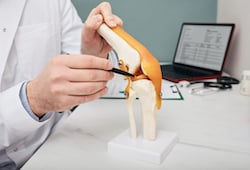 Case studies have long played a crucial role in medicine, providing a detailed analysis of a patient's medical condition and treatment. They serve as instructive examples for healthcare professionals who may encounter similar cases.
Case studies have long played a crucial role in medicine, providing a detailed analysis of a patient's medical condition and treatment. They serve as instructive examples for healthcare professionals who may encounter similar cases.
By examining a case in-depth, you can learn about clinical features and the reasoning behind selecting a particular treatment option. The study's inherent value lies in offering a practical and informative approach to learning.
This recent case study does precisely that. "Novel Extracorporeal Magnetotransduction Therapy with MAGNETOLITH and Focused Electromagnetic Extracorporeal Shockwave Therapy in Medial Meniscal Tear - A Case Report" by Prof. Dr. Karsten Knobloch was published in the Journal of Regenerative Medicine and offers a breakthrough combination therapy approach in the treatment of medial meniscal tears.
What are the Traditional Treatments for Medial Meniscal Tears?
 Meniscal tears are defined as either traumatic or degenerative. A meniscus tear as the result of trauma, by definition, has a higher degree of degeneration than an intact meniscus. When tearing occurs, it leads to pain and lower quality of life, limiting participation in activities once favored. The differential diagnosis is not always straightforward and may involve MRI imaging in addition to physical examination to reveal the full extent of the condition.
Meniscal tears are defined as either traumatic or degenerative. A meniscus tear as the result of trauma, by definition, has a higher degree of degeneration than an intact meniscus. When tearing occurs, it leads to pain and lower quality of life, limiting participation in activities once favored. The differential diagnosis is not always straightforward and may involve MRI imaging in addition to physical examination to reveal the full extent of the condition.
Typically, conservative management includes physical therapy along with avoidance or pause of further physical athletic activity. Surgery is most often reserved for traumatic cases.
Case Report Highlights
This case is reported in accordance with the CARE guidelines for case reports. The case features the novel clinical combination of high-energy focused ESWT with novel EMTT for medial meniscal tear visualized through MRI and ultra-high frequency ultrasound.
Patient: 41 yr old male runner
Symptoms: Complained of medial knee pain without a prior traumatic event
Physical examination: Locking pain provoked on the medial knee joint space
Assessment and Therapeutic Interventions
A thorough assessment was completed, and a diagnosis was reached through imaging and physical examination.
Imaging Assessment: Ultra-high frequency 33MHZ ultrasound and Tesla MRI
Diagnosis: Complex medial meniscal tear with a ganglion formation
Conservative approach: Unique combination therapy; non-invasive EMTT, 8Hz, 6000 shots, energy level 8/8 (using the MAGNETOLITH device from STORZ Medical) and focused ESWT using .25 mJ/mm2, 4000 shots, 4Hz, STORZ Medical device for three sessions on a weekly interval.
Physical Therapy: A regimen of strengthening of thigh and proprioceptive work
The patient experienced no side effects or complications from EMTT or ESWT treatment, and no bleeding or hematomas occurred.
Clinical Outcomes and Conclusions
At 3- and 6-months post-treatment, ultra-high frequency ultrasound showed a stable scar within the medial meniscal tear and no signs of locking. Furthermore, a favorable appearance was seen under stress testing with knee flexion and extension.
Comparable elasticity was achieved in the patient's menisci, affected vs. healthy side. And running increased to 3 x7 miles/week with no signs of pain at six months. The study includes impressive imaging demonstrating the superb outcome.
This is the first report on this non-invasive dual treatment with focused shockwave and EMTT in a medial meniscal tear. The healing of the meniscal tear is demonstrable, as seen on impressive imaging demonstrating the superb outcome.
One must differentiate between the focused and radial pressure shockwave as the latter does not achieve the energy flux densities discussed in the study. The two have differences in how the waves are generated, the depth of tissue penetration, and the shape of their waves.
When comparing ESWT devices, it's important to consider energy flux densities:
- Nano/very low energetic: 0.01–0.05 mJ/mm2
- Low energetic: 0.07–0.10 mJ/mm2
- Medium energetic: 0.12–0.25 mJ/mm2
- High energetic: >0.25 mJ/mm2
While ample evidence has been collected and published over 20 years on the beneficial effects of focused shockwave on multiple bone conditions, including delayed unions and nonunions, stress fractures, and osteoarthritis, no clinical papers have focused on meniscal tears.
The combination of EMTT (MAGNETOLITH device powered by STORZ Medical) with focused energetic ESWT for three sessions on a weekly interval significantly accelerates and advances healing in medial meniscal tears.
Harness the Power of Combination Therapy to Accelerate Healing
Combining these innovative technologies enhances the power of both, leading to beneficial patient outcomes. Add this to your protocol for patients sidelined by medial meniscal tears.
Expanding the range of non-invasive treatments offered by your practice can facilitate a range of benefits for patients and practice alike. By positioning your practice as a leading provider of regenerative therapies in your area, you can handily differentiate yourself from competitors and attract an expansive and loyal patient base.
Providing game-changing treatment options like ESWT and EMTT is gratifying and enables you to deliver faster and more effective patient recoveries. CuraMedix offers a wealth of resources on the latest regenerative solutions, making integrating these technologies into your practice easy.
Want to learn more about the impact of EPAT, ESWT, and EMTT on patient care? Our team of experts is always available to answer your questions and offer guidance. Get in touch with us today to discover more.



